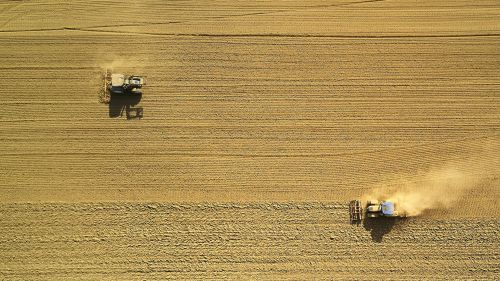The Science and Limitations of Farm-Based Carbon Offsets

Agriculture has great potential for carbon offsets, but implementation will be complicated.
Editor’s Note: Leaders at COP26 reached a deal establishing rules for international carbon offset markets. Agriculture has the potential to play a key role in carbon offset markets. This piece examines the science that would make that possible, as well as the limitations the sector will have to grapple with in establishing effective and fair carbon markets.
Efforts to reduce greenhouse gases in the atmosphere have spurred interest in converting farmlands to carbon sinks. This growing interest is evidenced by the increasing number of startups and nonprofits that seek to establish carbon market platforms, of large food-producing companies that seek to mainstream regenerative agriculture, and the Biden administration’s proposed carbon market.
At first glance, the logic behind farm-based carbon offsets seems straightforward: public and private entities pay farmers to adopt climate-friendly practices that absorb carbon from the atmosphere in lieu of directly reducing emissions from the buyer's operations.
But what is the science behind farm-based carbon offsets and how do we know if they really work?
What Are the Farm Management Practices That Can Sequester Carbon?
Atmospheric carbon dioxide is absorbed by crops, plants, and trees via photosynthesis and stored as carbon in biomass—that is roots, branches, and trunks—as well as soils. The amount of carbon that is stored in biomass and soil depends on site-specific farming practices, crop or vegetation cover, climate, and soil type, and can vary widely. A few examples of agricultural practices often linked to farm-based carbon offset programs are:
- Adopting conservation tillage or planting perennial crops reduces soil disturbance that releases carbon dioxide into the atmosphere.
- Shifting to cover crop rotations improves soil health and helps absorb carbon dioxide by keeping the ground covered between crop rotations.
- Managing the grazing of livestock by adjusting stocking rates, timing, and intensity of grazing allows grazed grasslands more time to recover, which in turn improves soil health and promotes carbon sequestration.
The mechanisms through which these practices increase soil carbon storage are relatively well-studied, though there is still much debate on whether some of these practices result in net climate benefits when soil carbon is properly measured. Farmers may benefit from supplemental payments from carbon markets, as many struggle to keep their business afloat due to rising production expenses and stagnant crop prices. However, several key challenges threaten the validity of farm-based carbon offsets.
What Are the Current Limitations of Farm-Based Carbon Offsets?
For one, there are limited tools and methodologies that can affordably verify the amount of carbon stored in soils at the scale and level of accuracy needed by a carbon market. Soil carbon stocks are traditionally measured through field surveys; however, such methods may be prohibitively expensive for small farmers. Unlike easily measurable point source emissions such as power plants or manufacturing facilities, most agricultural emissions are diffuse and highly variable. A previous report found that offering uniform payments for the adoption of climate-friendly agricultural practices was far more expensive than performance-based payments due to the high spatial variability of soil carbon storage.
Soil carbon storage is also impermanent, as previously captured carbon can be re-emitted into the atmosphere through a shift to less climate-friendly practices or severe weather conditions. For example, most of the carbon sequestered through no-tillage practices are stored near the soil surface and may be re-released if farmers till the land in the future. Limitations in how much soil carbon can be stored also potentially disadvantages farmers who are early adopters of climate-friendly practices as their soils may be carbon saturated. Further, as some of the carbon-storing practices such as perennial cropping and alley cropping can reduce crop yields, farmers may be incentivized to expand farmland elsewhere. If the expansion involves highly emissive practices such as the conversion of natural ecosystems into farmlands, the intended storage benefits will likely be nullified.
Farm-based carbon credits also only reduce overall greenhouse gas emissions if they incentivize farmers who would not have otherwise adopted climate-friendly practices to do so, something referred to as additionality. Additionality of current carbon offsets are often put into question, especially as current carbon prices are too low to be profitable for many farmers. The High-Level Commission on Carbon Prices estimated in 2017 that carbon prices would have had to rise to $40-80 by 2020 in order to tackle climate change, with recent studies suggesting much higher marginal carbon costs; yet the most prominent carbon market startups are offering prices at about $10-15 per ton of carbon dioxide. If greenhouse gas reduction is not additional, then the purchase of a carbon credit in place of a direct reduction in emissions may not actually reduce overall greenhouse gas emissions.
As the achievement of global climate goals such as the 1.5 C target of the Paris Climate Agreement requires ambitious emissions reductions in the agricultural sector and all other economic sectors, there is concern that farm-based carbon credits used to offset emissions from other sectors may preclude the achievement of global climate goals. This suggests that broader climate goals can likely only be achieved via direct reductions in emissions rather than through the purchase of offsets from the agricultural sector, whose emissions also need to be reduced. Stakeholders interested in a farm-based carbon market should seek to address its current limitations, including by investing in scalable soil carbon measurement technology and by increasing carbon prices to reflect current scientific understanding of the significant impacts of climate change.